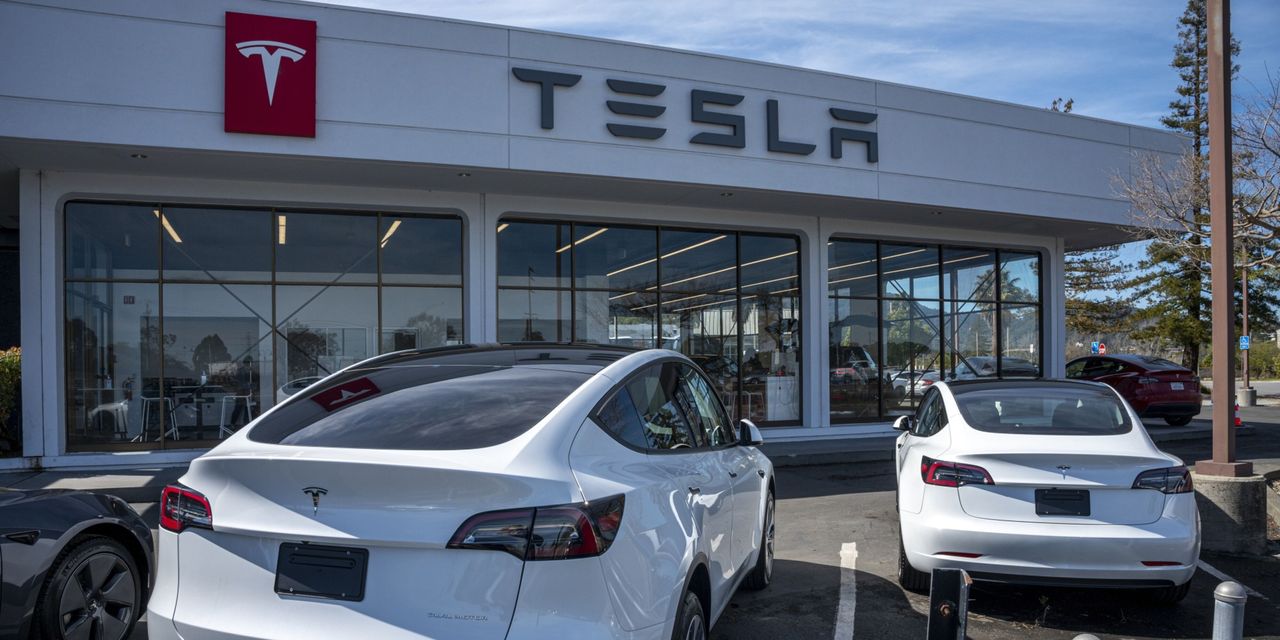Tesla
delivered 466,140 vehicles in the second quarter. That’s a record and better than Wall Street expected. It’s a very good result and investors love a strong ‘beat,’ still, it might not be enough to keep the stock moving higher, considering the starting point.
The more than 466,000 units compares with about 423,000 delivered in the first quarter of 2023, and about 255,000 in the second quarter of 2022, when much of China was locked down to fight Covid-19.
Wall Street was looking for deliveries of about 445,000 to 447,000 cars. The company-compiled consensus call is about 447,000 units, close to the number compiled by Bloomberg. The consensus estimate on
FactSet
was about 445,000 units.
Tesla
beat those numbers by roughly 4% or 5%.
Tesla (ticker: TSLA) produced 479,700 units, also a record for any quarter. The gap between production and deliveries is 13,560. That’s a small negative. Still, the almost 14,000 number is smaller than the 17,933 difference between production and sales in the first quarter of 2023.
A small gap between production and deliveries, when sales are growing, isn’t a surprise, but investors have been following the number, wondering if rising vehicle inventories means demand is waning.
Tesla has produced about 99,000 more cars than it has sold over the past few years. That level represents roughly 19 days of inventory. That’s low. The traditional auto industry typically operates between 30 and 60 days of sales on dealer lots.
Even though Tesla’s number doesn’t compare to the overall industry, it makes sense to pay attention to the change in the Tesla number.
Taking all the information provided in the second quarter report into consideration, it still isn’t easy to call what will happen to Tesla stock on Monday. Barron’s guess is flat. (Barron’s picked Tesla stock on Jan. 6, believing it would be a good year for Tesla.)
Maybe we are conservative. Wedbush analyst Dan Ives expects shares to rise ahead of the July 4th holiday in the U.S. “Bears were expecting a bad print,” he tells Barron’s. “This was a trophy case quarter [for Tesla].” He rates Tesla shares Buy and has a $300 price target for Tesla stock.
Numbers are good. Still starting points matter. Coming into Monday trading, Tesla stock is up 22% over the past month and up 113% so far this year. The
S&P 500
and
Nasdaq Composite
are up about 16% and 32% this year, respectively.
It’s the third-best start to a year in the history of Tesla stock. Shares gained about 158% in the first half of 2020 and about 217% in the first half of 2013. Tesla stock was one of 13 stocks in the
Russell 1000
to double, or better, in the first half of the year. That kind of performance means investors want excellent news when things such as deliveries or earnings come up.
Delivering almost 20,000 units more than Street estimates is very good news, but is it good enough news?
Bernstein analyst Toni Sacconaghi called results “solid” in a Sunday report. It isn’t enough to knock him off his Sell rating. He still has his concerns. “Despite significant price cuts and quarter-end promotions in Q2, lead times on all Tesla models are low,” wrote the analyst. “We believe the company drew down backlog in Q2.” That means deliveries were greater than orders. Combined with low lead times he is still worried about demand.
Sacconaghi’s price target is $150 a share.
Whatever happens, the reaction to a delivery report gives investors information, but it doesn’t always, if ever, set the long-term direction of the stock. Deliveries were fine. Tesla stock, don’t forget, dropped 6% after record Q1 deliveries were reported on April 2. Shares closed at $194.77 on April 3, the trading day after deliveries were released. They closed the first half at $261.77.
When delivery numbers beat the Street, Tesla stock typically goes up between the delivery report and earnings about two-thirds of the time. It isn’t hard to understand why. Better deliveries mean rising earnings estimates.
Tesla’s second quarter earnings report is slated for July 19. Wall Street is projecting earnings per share of about 77 cents, down from 85 cents reported in the first quarter. That looks low now, given deliveries. EPS matters, but the most closely watched number coming in the second quarter financial results might be operating profit margins.
Tesla cut prices significantly at the start of 2023 to boost demand amid rising interest rates and a slowing economy. Lower prices have kept demand high but at the expense of profit margins.
Operating-profit margins fell to about 11% in the first quarter from 19% a year earlier. For the second quarter, analysts project stable operating profit margins of about 11%, down from about 15% reported in the second quarter of 2022.
For the full year, Wall Street expects Tesla to deliver about 1.8 million units. If Tesla just repeats the second quarter number in the third and fourth quarter it will end up delivering about 1.82 million units. Over the past 12 months, Tesla has delivered 1.64 million vehicles.
Write to Al Root at [email protected]
Read the full article here











